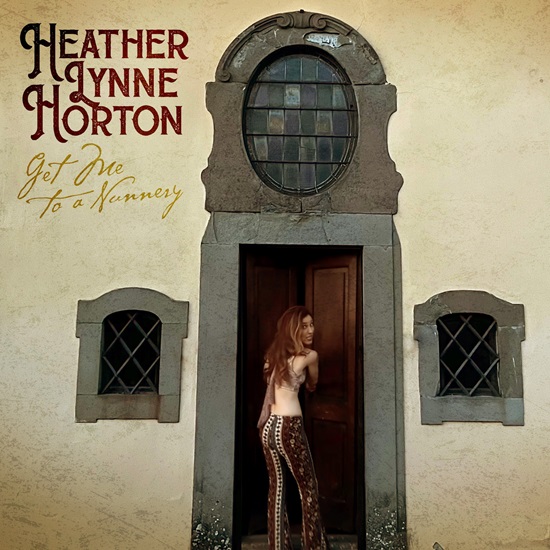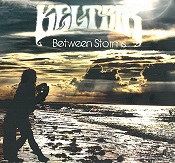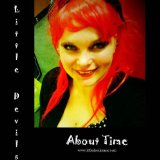
‘Get Me to a Nunnery’ is Heather Lynne Horton’s third album, following 2012’s ‘Postcard Saturdays’ and 2017’s ‘Don’t Mess with Mrs Murphy’. You might think that’s a fairly relaxed pace, but she has had other priorities, including raising her daughter and collaborating with her husband, Michael McDermott, on his solo and Westies albums. She’s even done a bit of touring with Michael as well. As you might expect, Michael features heavily on the album along with other collaborators like Will Kimbrough, although the concept, production and direction of the album are purely down to Heather.
There’s a theme running through the album which is strongly hinted at by the title. It’s the oppression of outsiders and minorities; the ones who don’t have the power to challenge when they’re told “That’s just the way it is”. There are some production and musical themes that run through the album as well. There’s an overall dreamy, ethereal feel that’s partly created by Heather’s layered lead and backing vocals that hint at sixties-era Marianne Faithfull, particularly on the album’s opening song.
‘After All This Time’ is slightly uncharacteristic in that underneath Heather’s vulnerable vocal the song builds up to a Spector-like wall of sound arrangement as it tells the story of a relationship that’s survived everything life can throw at it.
The two most vehemently anti-oppression songs on the album both feature Heather’s violin playing. ‘Ten Times’, with its lead vocals panned left and right deals with difficulties women find when the have to work ten times as hard as men to succeed and ‘Call a Spade a Spade’ with a sparse, almost sinister arrangement enhanced by the occasional single sour piano note as it highlights the racism that is still with us almost seventy years after Rosa Parks refused to give up her seat on the bus.
‘You Said So’ and ‘Take Off’ both have an autobiographical flavour, with the latter metaphorically linking air travel with a career in the music business highlighting the conflict between family and professional life; you can’t give one hundred per cent to both. The album’s final piece, ‘Lin’s Never-Ending Song’ is a condensed classical string quartet, hinting at Bach, with several movements and various tempi and techniques, including a pizzicato passage and lots of counterpoint that demonstrate Heather’s violin and arrangement virtuosity. It’s a lovely way to finish the album.
The dreamy soundscapes of ‘Get Me to a Nunnery’ create a seductive and subversive framework to soften you up before Heather delivers the subtle lyrical punches. The album was inspired by and is dedicated to Sinead O’Connor, who died just as the recording was completed; it’s a fitting tribute.
‘Get Me to a Nunnery’ is out now on Pauper Sky Records (PSR015).
Here’s the video for ‘After All This Time’:
As an added bonus, here’s a shot of Heather from her UK tour with Michael McDermott in 2017:

 So, what happens when you get to The 100 Club just as the doors open for a private event on a Sunday evening? Well, the obvious answer is, not a lot, so plenty of time to check out how the stage set-up looks and work out the best photo angles for later. When that’s done, there are still only four people in the place, so what next? Right, ask the sound engineer about the programme for the night; apparently The Grahams (the band I’ve come to see) are going on at 9:30. Is there a support band, don’t know mate. Oh well, time for another bottle of lager then.
So, what happens when you get to The 100 Club just as the doors open for a private event on a Sunday evening? Well, the obvious answer is, not a lot, so plenty of time to check out how the stage set-up looks and work out the best photo angles for later. When that’s done, there are still only four people in the place, so what next? Right, ask the sound engineer about the programme for the night; apparently The Grahams (the band I’ve come to see) are going on at 9:30. Is there a support band, don’t know mate. Oh well, time for another bottle of lager then.
Then, out of nowhere, the door opens and what is unmistakably a bunch of musicians walks in; the instrument cases are always a giveaway. After about half an hour of intensive roadying and oneing and twoing, we have ignition. None of this leaving the stage and coming back to make an entrance; a quick line check on the vocal mics and its 1-2-3-4.
Surprisingly, after all the last minute preparation, The Orange Circus Band was pretty good, playing hillbilly Americana with a constantly changing instrumental line-up featuring bass, acoustic guitar, banjo, mandolin and fiddle and featuring a bit of the almost obligatory Woody Guthrie. They finished with the lovely four-part harmonies of the gospel song “I’ll Fly Away” and everyone was happy, but I can’t help wondering how much better they could have sounded, with a full-on soundcheck.
No such problems for The Grahams; they soundchecked before the venue opened and blasted straight into the set with “Griggstown” from the new album, “Glory Bound”. Although Doug and Alyssa Graham’s second album was released this week in the UK, this gig was about the short documentary, “Rattle the Hocks”, made at the same time, about the influence of the railways on the growth of Americana music, which is showing at Raindance Film Festival. Although the album versions of the songs feature full band arrangements, the songs are so good that they all work with two guitars, two voices and a bit of percussion. The set featured mainly material from “Glory Bound” including “Kansas City”, the folky and personal “Blow Wind Blow”, the album’s closing song, “The Promised Land”, “Tender Annabelle” from the bonus tracks and the double entendre-laden “Biscuits”. All of those were delivered with style and panache, but there were also a few very special moments.
About halfway through the set, the first highlight was the gospel-tinged and deeply personal “Mama”, which was the first really emotional moment, followed fairly quickly by “The Wild One”, which is a standout track from the album. It’s a tragic coming-of-age story with a huge uplifting chorus and it’s a single if I ever heard one. It’s gorgeous. “Lay Me Down” was another album high point which translated perfectly to a more stripped-down format and had Alyssa shifting from her pure and clear country tones to something much more like Alanis Morissette or eighties Marianne Faithfull. Which just left “Glory Bound”, inspired by Woody Guthrie’s “The Farmer-Labor Train” as the unplugged encore and a final lovely moment.
Seeing The Grahams live was quite an experience. Doug and Alyssa built a warm rapport with the audience by talking about the film, the album and their relationship, emphasised by their obvious onstage chemistry. The songs are intensely personal and are delivered with passion, power and beautiful harmonies; by the end of a gig, you’ll feel elated but wrung-out. If you missed this one you can catch them on their UK tour in November.
 “Between & Beyond Storms” is the second album from Cambridge-based duo Keltrix, who are Keri Kel (singer, songwriter and guitarist) and Sharon Sullivan (violinist and producer) and it’s a bit of an interesting one. There’s a combination of folk and Celtic roots with elements of rock, reggae, trip-hop and harder-edged dance beats. The Keltrix mission seems to be to create something new by fusing all of these elements into a new genre. It’s not just a double album, there’s a major tour and a documentary film to follow; there’s a lot of creativity and plain hard graft going into this. So, does it work?
“Between & Beyond Storms” is the second album from Cambridge-based duo Keltrix, who are Keri Kel (singer, songwriter and guitarist) and Sharon Sullivan (violinist and producer) and it’s a bit of an interesting one. There’s a combination of folk and Celtic roots with elements of rock, reggae, trip-hop and harder-edged dance beats. The Keltrix mission seems to be to create something new by fusing all of these elements into a new genre. It’s not just a double album, there’s a major tour and a documentary film to follow; there’s a lot of creativity and plain hard graft going into this. So, does it work?
As always, this is purely a personal opinion; feel free to tell me if you think I’m wrong, but I’m not convinced. For me, the strongest tracks are on the “Beyond Storms”. The reworking of “Alibi” as “My Alibi” works and, in the middle of the set, “Displacement” and the remix of “Endure” both have an ambient, trip-hoppy feel and lots of space, allowing the songs plenty of room to breathe. These three songs, particularly “Displacement”, would stand up alongside anything else I’ve heard this year.
And that’s the upside, but there is a downside. There are a few things that don’t work at all for me and they’re connected with the individualism the band is trying to create. Keri Kel’s singing mashes up folk intonations and inflexions with elements of Kate Bush and Lene Lovich (maybe even Marianne Faithfull from the seventies onwards) and sometimes becomes a distraction, pulling the attention and focus away from the song. There’s also a bit of a kitchen sink mentality; there are loads of ideas bouncing around and it seems to be important to try to cram all of them in, so we get songs with lots of tempo changes and lyrics which sound rushed to try and fit in with the melody.
Keltrix mixes up a huge variety of styles and getting the blend right isn’t something that happens overnight. If you look at this album as part of the journey, rather than the ultimate destination, then it makes a lot more sense.
“Between & Beyond Storms” is out now.
![220px-Ssilverstein[1]](http://musicriot.co.uk/wp-content/uploads/2014/08/220px-Ssilverstein1-211x300.jpg) How did I discover Shel Silverstein? Easy, I bought a copy of the Dr Hook and the Medicine Show album “The Ballad of Lucy Jordon” (a contractual obligation “greatest hits” package put together by CBS before the band departed to Capitol and commercial success). As an introduction to early ‘70s Dr Hook, it’s a belter. Released in 1975, it was obviously a vinyl album; you remember those, don’t you? I bought it on the strength of the chart hit “Sylvia’s Mother”, but that wasn’t even close to being the best song on the album; that’s at the end of the album and the end of the next paragraph.
How did I discover Shel Silverstein? Easy, I bought a copy of the Dr Hook and the Medicine Show album “The Ballad of Lucy Jordon” (a contractual obligation “greatest hits” package put together by CBS before the band departed to Capitol and commercial success). As an introduction to early ‘70s Dr Hook, it’s a belter. Released in 1975, it was obviously a vinyl album; you remember those, don’t you? I bought it on the strength of the chart hit “Sylvia’s Mother”, but that wasn’t even close to being the best song on the album; that’s at the end of the album and the end of the next paragraph.
A quick look at the album sleeve showed that fifteen of the sixteen songs were written by someone called Shel Silverstein, who wasn’t even a member of the band, and they were a fascinating collection of songs, ranging from the country pastiche of “The Wonderful Soup Stone” through the Rabelaisian comedy of “(Freaking at) the Freakers’ Ball” and “Roland the Roadie and Gertrude the Groupie” to the superb ( and much-covered) story of a suburban breakdown, “The Ballad of Lucy Jordon”. If you don’t listen to anything else picked out in this piece, you really should listen to the Marianne Faithfull version of this song.
I know this is a nostalgia piece, but there are a lot of things that weren’t better in the old days. In the 21st century, you can find out almost everything about a group or artist within seconds; you can get a biography, you can listen to their material (released and unreleased), you can probably get a message to them directly and they might even reply. In the mid-to-late 70s, you had NME, Sounds, Melody Maker, John Peel and some independent record shops to let you know what was going on. Although I was only really interested his music, I discovered that there was much more to Shel Silverstein than songs; he was also a gifted cartoonist, poet, screenwriter author of childrens’ books.
Eventually, I managed to track down a couple of imported albums (“Songs and Stories” from 1978 and “The Great Conch Train Robbery” from 1980). While the albums didn’t have the polish of the Dr Hook material, they covered a lot of the same territory and gave the impression that once Shel had an idea he had to get it down and move on quickly because there were ten more ideas banging on the door behind it. I loved “Songs and Stories”, from the sheer silliness of “Goodnight Little House Plant”, “Someone Ate the Baby” and “Never Bite a Married Woman on the Thigh” through “The Father of a Boy Named Sue” (he also wrote “A Boy Named Sue”) to the epic stoner poem “The Smoke-Off” and the ode to cop-outs, “They Held Me Down”. It had all the manic energy of a live performance by Robin Williams, who was just emerging as a stand-up at the time.
Shel Silverstein was that rare example of genuine Renaissance Man; he had gifts ranging across the field of creative arts, but it was as a songwriter (and ramshackle, shambolic performer) that I love his work. His serious work, such as “The Ballad of Lucy Jordon” was superb, but he also wrote comedy songs that were actually funny ( I still laugh out loud at the lines: ‘Everybody ballin’ in batches, pyromaniacs strikin’ matches’ from “Freakin’ at the Freakers’ Ball”) and you could bear to listen to more than once. It helped that he drew a lot of his humour from the fringes of society and legality, which gave it an extra frisson to anyone looking in to that world from the outside.
You rarely hear Shel Silverstein’s name mentioned these days, which is a shame, but he has left a huge legacy in print and in music. If you’re still not convinced, just ask yourself what these songs have in common: “A Boy Named Sue”, “Queen of the Silver Dollar”, Sylvia’s Mother”, “25 Minutes to Go” and “Daddy What If”? Yep, all written by Shel Silverstein. Most songwriters would kill to have written any one of those songs, and that’s before you even get to “The Cover of the Rolling Stone” and the sadly under-rated “Last Mornin’”. He’ll make you laugh and he’ll make you cry, but he’ll never bore you.
 Of the original 2010 line-up of Little Devils, singer Yoka (who also plays some very nice sax and flute) and bass player Graeme Wheatley are still with the band, joined by later recruits Big Ray (guitar) and Sara Leigh Shaw (drums and backing vocals) to complete the 2014 version. “About Time” is a seven-track EP showcasing the band’s current material and, partly, creating a comparison with their earlier work. All of the playing is high quality throughout, but it’s Yoka’s superb voice which really sells the songs, from the uptempo belter, “The Waiter”, which appears here in two versions, the older version with harmonica and the newer version with sax, to the slow, powerful ballad, “Another Pack of Lies”.
Of the original 2010 line-up of Little Devils, singer Yoka (who also plays some very nice sax and flute) and bass player Graeme Wheatley are still with the band, joined by later recruits Big Ray (guitar) and Sara Leigh Shaw (drums and backing vocals) to complete the 2014 version. “About Time” is a seven-track EP showcasing the band’s current material and, partly, creating a comparison with their earlier work. All of the playing is high quality throughout, but it’s Yoka’s superb voice which really sells the songs, from the uptempo belter, “The Waiter”, which appears here in two versions, the older version with harmonica and the newer version with sax, to the slow, powerful ballad, “Another Pack of Lies”.
Two tracks in, listening to “Good Times” (which evokes Springsteen’s “Spirit in the Night”), you could be forgiven for thinking that this EP would be full of fast blues/rock party songs with powerful vocals but the third track, “Hang my Head” disproves that theory both musically and lyrically. It’s a slow/mid-tempo relationship song with clean guitar arpeggios, a nice sax solo, and a lead vocal which proves that Yoka is much more than a blues shouter. “No Love Lost” is mid-tempo and funky with a flute solo to add a slightly different texture.
“Walking Disaster” brought back memories of Marianne Faithfull’s “Why’d Ya Do It?” from her classic album “Broken English”. It covers the same lyrical territory, but Yoka’s vocal on this track also captures the same cracked intensity as Faithfull’s vocal. “Another Pack of Lies” is a standout track, a slow song which builds from a quiet intro to a big finish with perfect vocal harmonies. The song’s theme is social injustice and exploitation viewed from various perspectives and it works perfectly as a contrast to songs like “Good Times”. The EP finishes with the earlier version of “The Waiter” and I’m not sure if it’s a valuable addition or not; decide for yourself.
I’m pretty sure that the “About Time” EP (with its very clever retro seven-inch packaging) is intended as a showcase for Little Devils; if that’s the aim, then it’s a success. The songs here cover a broad spectrum from slow-tempo social comment to uptempo fun and the addition of Yoka’s saxophone and flute creates new textures and possibilities for the band. This is a thoroughly accomplished piece of work from a studio band but, on the strength of this, I can’t wait to see them live.
Released February 20, 2014.
 I first heard about the Radio (in my) Head project over a year ago when I met up with a couple of the people involved in putting the album together. It’s fair to say that it’s been a fairly long flash-to-bang time, but the end result certainly is a cracker (sorry). We’ve been publishing fairly regular updates on the album’s progress and reviews of the singles released so far (as well as a few unrelated singles from the artists involved), so the final release could have been an anti-climax; it isn’t, because this is a very, very good album. Normally, I’d give you a bit of background on the artists, but there are eleven of them, so you can find all you need to know here. I try to avoid track-by-track reviews as well, but there really isn’t any choice here, so I’ll start at the beginning, leaving out the songs we’ve already reviewed as singles.
I first heard about the Radio (in my) Head project over a year ago when I met up with a couple of the people involved in putting the album together. It’s fair to say that it’s been a fairly long flash-to-bang time, but the end result certainly is a cracker (sorry). We’ve been publishing fairly regular updates on the album’s progress and reviews of the singles released so far (as well as a few unrelated singles from the artists involved), so the final release could have been an anti-climax; it isn’t, because this is a very, very good album. Normally, I’d give you a bit of background on the artists, but there are eleven of them, so you can find all you need to know here. I try to avoid track-by-track reviews as well, but there really isn’t any choice here, so I’ll start at the beginning, leaving out the songs we’ve already reviewed as singles.
The opening track, “The National Anthem” by STRNGRS, which eases the listener into the album doesn’t depart radically from the “Kid A” original but replaces the funk groove with a rockier, heavier feel, a bass sound that wouldn’t be out of place on a Kasabian track and a vocal with more than a nod in the direction of Brian Molko. You just know that Black Casino and the Ghost will put their own very individual stamp on “Packt like Sardines in Crushed Tin Box” with an incredibly heavy bassline and Elisa Zoot’s breathy but powerful vocals driving the song along; it doesn’t disappoint.
Stoneface Travellers are the first band to really make a song their own with a version of “My Iron Lung” that replaces the original’s “Dear Prudence/ Lucy in the Sky…” guitar sounds with straight ahead blues riffing. Where the original breaks down into a noisy middle section, this becomes quieter ahead of an extended solo from Emile Gerber. It’s the first radically different version on the album. Yoya’s take on “Wolf at the Door” replaces the mainly acoustic instrumentation of the original with samples played backwards and forwards, loads of electronic sounds and a vocal which goes from pure to fractured in the space of one line; it took Marianne Faithfull twenty-five years to do that.
There are good, and very good vocal performances on the first half of the album, but the first truly outstanding vocal is on Amy Hannam’s version of “Street Spirit (Fade Out)”. The song builds gradually from a chiming guitar intro with the piano providing the bass and a very close-miked vocal which demonstrates the quality and power of Amy’s voice, particularly when joined by the perfect harmonies in the chorus. It has a very 70s prog feel at times; there’s a passage where the vocal is reminiscent of Pink Floyd’s “Great Gig in the Sky” and the piano is straight out of “Tubular Bells”. And, yes, it does fade out. Skeye’s version of “Karma Police” again has a retro feel using traditional rock band instrumentation and adding organ to the mix in traditional 70s style. The vocal is pure and clear until pushed hard when it becomes more raw and rocky and it’s another song stamped with the style of the performer.
Malin Andersson’s version of “Exit Music (For a Film)” has electric and acoustic guitars providing the backing for Malin’s breathy vocal (close-miked again) before adding a violin, in contrast to the original’s drums and synths in the final third of the song ; it’s another excellent version. Alexey Zelensky tackles the only non-album track of the project, “Staircase”, which was released on “The Daily Mail” single. Many of the elements of the arrangement are similar to the original, including the UK garage/drum ‘n’ bass drum patterns and chiming guitars but Alexey adds some powerful multi-tracked lead and backing vocals and guitar. And I think you can guess what’s coming at the end of the album.
The closer is Bethan Mills’ version of “Creep” and it’s a classic. I must admit to hearing a demo version of this a few months ago and it’s been really difficult to keep this one secret; it’s a powerful and original take on the song that Thom Yorke seems to hate so much now. The song opens with understated piano before Bethan’s (close-miked again), intimate vocal comes in. Drums and bass kick in after the first chorus, but the vocal still punches through the arrangement. There’s a breakdown back to the opening arrangement on the “Whatever makes you happy…” verse before an epic finish featuring a big guitar solo with squalls of controlled feedback drop out to leave a plaintive vocal to end the song. I’m a huge fan of the Chrissie Hynde unplugged version of “Creep”, but I think this version just shades it in a straight fight.
So, it could have easily been a bunch of tired retreads of Radiohead songs but it’s much, much more than that. Project curator John O’Sullivan has pulled together a bunch of people from all over the world to put their own stamp on their favourite Radiohead songs. Listening to the album for the first time, you have no idea of what’s coming next and the surprises are all pleasant. There aren’t any average tracks here; they’re all well thought-out and very well performed. My personal highlights are Amy Hannam’s version of “Street Spirit” and Bethan Mills’ version of “Creep”, but I’ll happily listen to any song on this album.
The good news is that from October 29, you can hear the album in all its glory by downloading it on iTunes here.
What are the odds on Portis(in my)Head next?
 Nadine Shah has made a good, albeit slightly anonymous, debut album which has one major downfall; her purposely dour and low delivery combined with Ben Hillier’s swampy, stylistic production with tales of troubled men and put upon women positively encourages immediate comparison to the Gothic Elite. PJ Harvey, Nick Cave, Marianne Faithfull are names you will undoubtedly see in reference to Shah’s work and as the first track “Aching Bones” moans and trudges into view there is no getting away from the similarities between this and Harvey during her exaggerated and traumatised blues vamp that she inhabited during her vivid “To Bring You My Love” period. Drawing comparisons to such iconoclasts is a risky business but “Love Your Dum and Mad” goes some way towards proving that there is enough room for everyone.
Nadine Shah has made a good, albeit slightly anonymous, debut album which has one major downfall; her purposely dour and low delivery combined with Ben Hillier’s swampy, stylistic production with tales of troubled men and put upon women positively encourages immediate comparison to the Gothic Elite. PJ Harvey, Nick Cave, Marianne Faithfull are names you will undoubtedly see in reference to Shah’s work and as the first track “Aching Bones” moans and trudges into view there is no getting away from the similarities between this and Harvey during her exaggerated and traumatised blues vamp that she inhabited during her vivid “To Bring You My Love” period. Drawing comparisons to such iconoclasts is a risky business but “Love Your Dum and Mad” goes some way towards proving that there is enough room for everyone.
The first half of the album is packed out sonically, full and dusty with looped samples and reverb. Songs like the excellent “To Be a Young Man” and in particular “Runaway” (‘Did you ever stop to notice I too worked hard to build this home, and now I am of no use to you now that the children have grown’) are character-based songs sung in the first person with Shah deliberately exaggerating her northern accent, she sings with it throughout, to colour the mood wonderfully. Later on the album does she confuse slightly with more traditional ballads such as “All I Want” which could be an Adele song, it’s soulful and surprisingly radio friendly with its electronic piano and ‘just sit in cafes and not say a word’ refrain. Another slower song and early single “Dreary Town” (an Adele song title if ever there was one!) is nice but considering its autobiographical relevance here (it’s about a former lover of Shah’s who because of bipolar disorder subsequently killed himself) it doesn’t pack the punch that it could and should.
“The Devil”, a song title so ubiquitous within the genre that not only has Anna Calvi, who was 2011’s PJ Harvey, but Harvey herself had ‘Devil’ songs and Shah’s attempt will almost certainly not be remembered as an essential addition to an already overcrowded collection and to include it here seems at best ill-advised. The deceptively hypnotic “Floating” does a lovely thing very early on and positions a very David Lynch type twanging, distorted instrumental break right where there shouldn’t be one; its beauty is slow burning and unsettling. “Filthy Game” is this album’s attempt at a “Surabaya Johnny” and Shah is a convincing, worldly-sounding narrator.
Nadine Shah has been making this record for four years and this goes some way towards explaining the varying levels of maturity that are evident from song to song; it’s a very grown-up record or at least wants to be but is occasionally betrayed by volatile songwriting with Ben Hillier’s production sometimes resembling too many other similar artists. Shah has an amazing voice and does not descend into histrionics where others would; given the potentially melodramatic subject matter here the temptation must have been great and her controlled performance throughout the entirety of “Love Your Dum and Mad” is indeed its greatest asset.


